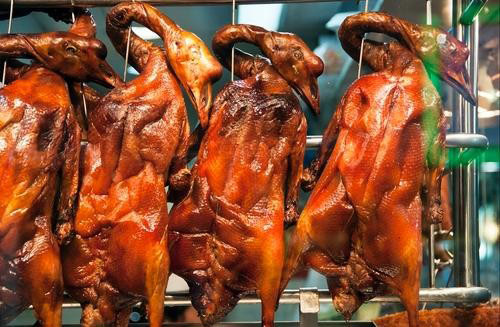|
查看原文
You know that thing? That thing that’s everywhere, and it sounds like something you should already know about, so you don’t really want to ask? Well, we know about it, and we’ll give you the intel.
How popular a delicacy is Peking duck? Popular enough to warrant an10,000 square-foot museum dedicated to it in China.
It’s located in the downtown Beijing branch of the restaurant chainQuanjude, which has been serving roast duck since 1864. (Not too shabby!) Among the 500 items on display are a coupon from a 1901 duck sale and photographs of Mao Zedong chowing down.
Peking duck ranks high among the Chinese dishes that have made the trek Westward, but there’s a lot to it that you may not know. We asked Ed Schoenfeld, the co-owner of Decoy, a Peking duck-themed restaurant that opened this past spring in New York City, to help us fill in the gaps.
How It’s Made: Peking duck takes several days to prepare. First, fatty birds bred specifically for the dish are pumped with air to separate the skin from its meat. This insures that the “skin [is] very crispy and the meat succulent,” said Schoenfeld. They’re then scalded with boiling water, painted with a sweet mixture of maltose and water, and hung inside a 500-degree oven for up to 75 minutes. Only then are the ducks artfully sliced and trimmed of excess fat.
What the Name Means: The dish takes its name from a now out-of-favor transliteration of “Beijing.” In English, the dish is often called “Beijing duck” or simply “roast duck.”
Where It Comes From: The first Peking duck was roasted some time during the early 15th century, when it was a popular dish on imperial court menus of the Ming Dynasty. During this era, “the really great chefs didn’t really work in restaurants,” Schoenfeld said. “They worked for patrons, much in the same way as a painter or a composer had a patron in court in Renaissance Europe.” These chefs helped define imperial cuisine, which in turn influenced the cuisine of the entire country.
How It’s Eaten: A Peking duck is often sliced tableside and served alongside cucumbers and scallions. The components are wrapped in a thin flour pancake, which is slathered with any of several savory sauces.
In the United States, the sauce is usually a thick-and-sweet Hoisin sauce, which is made with soy sauce, black bean paste, honey, and rice vinegar. But in China, Schoenfeld said, the sauce of choice is a ”sweet brown soybean-based sauce,” or in Beijing specifically, a salty “yellow soybean sauce that is its first cousin.”
Where It’s Eaten: In both the US and China, there are several restaurants devoted exclusively to the dish—Decoy and Quanjude being prime examples, respectively. But many restaurants also serve Peking duck in another way.
"In China, there’s banquet cooking," Schoenfeld said, which can be very elaborate (and expensive affairs). "Very often you eat Peking duck as one course of a ten-course banquet … [though] if you’re at a very elegant banquet, you’d only eat the skin of the duck."
While Schoenfeld said eating just the skin seems a terrible waste, he thinks a museum devoted to the dish is an excellent idea.
"I think we need to make a strategic alliance right away," he said of Quanjude. "I’d love to be one of the [museum’s] first visitors.”
|
查看譯文
知道這是什么嗎?看樣子你早就知道了,所以你也不想問對嗎?那就讓我來告訴你其中的奧秘。
北京烤鴨這道美味到底有多受歡迎?在中國有一個(gè)1萬平方英尺(約929平方米)以北京烤鴨為主題的博物館。
位于北京市中心的全聚德連鎖店自1864年起就開始做北京烤鴨了。在展出的500件物品中,有一張1901年的烤鴨購買券以及毛澤東吃烤鴨的照片。
在傳入西方的中國美食中,北京烤鴨名列前茅,不過其中仍有你不知道的奧秘。我們請教了Decoy餐廳的合伙老板舍恩菲爾德(Ed Schoenfeld),讓他為我們科普北京烤鴨的知識,Decoy是今年春天在紐約開張的一家北京烤鴨主題餐廳。
北京烤鴨是怎樣煉成的:制作北京烤鴨需要花幾天時(shí)間進(jìn)行準(zhǔn)備。首先專供制作北京烤鴨的肥美鴨肉要經(jīng)過真空處理,使皮肉分離。“這樣才能確保鴨皮酥脆,肉質(zhì)鮮嫩,”舍恩菲爾德說道。接下來把鴨子放入沸水白灼,并涂上用麥芽糖與水調(diào)配的醬料,最后放進(jìn)500度高溫的烤箱烹制75分鐘。只有這樣切成片的烤鴨才會肥瘦均勻。
名字的寓意:這道菜名由地名北京音譯而來。在英語中,我們通常叫做“北京烤鴨”或者直接叫“烤鴨”。
北京烤鴨從哪來:第一只北京烤鴨可追溯至15世紀(jì)早期,那時(shí)候這道菜在明朝皇室的菜單里十分受歡迎。在這一時(shí)期,“真正的大廚并不在餐館工作,”舍恩菲爾德說道。“他們?yōu)楣椭鞴ぷ鳎愃朴跉W洲文藝復(fù)興時(shí)期為王室工作的畫家和作曲家。”這些廚師立下皇家烹飪標(biāo)準(zhǔn),最終對整個(gè)國家的烹飪都產(chǎn)生了深遠(yuǎn)影響。
怎樣吃:北京烤鴨通常需要切片,佐以黃瓜和大蔥食用。所有食材都卷在一張薄薄的面餅里,并蘸上多種醬汁。
在美國,人們通常選用由醬油、黑豆醬、蜂蜜與米醋調(diào)配而成的濃稠而味甜的海鮮醬。但是在中國尤其是北京,舍恩菲爾德說,用的是一種“以黃豆為主制成的棕色甜醬”。
在哪吃:美國和中國都有不少北京烤鴨專賣店——Decoy和全聚德就分別是最好的例子。不過也有許多餐廳以其他方式供應(yīng)北京烤鴨。
“中國有宴會,”舍恩菲爾德說,宴會的菜肴十分精致(當(dāng)然價(jià)格也不菲)。“通常烤鴨只是十道宴會菜肴中的一道……如果你出席的是一場高雅的宴會,那么你只能吃到鴨皮。”
盡管舍恩菲爾德說只吃皮似乎很浪費(fèi),不過他認(rèn)為烤鴨專營店是個(gè)極好的主意。
“當(dāng)務(wù)之急是要建立戰(zhàn)略合作聯(lián)盟,”談起全聚德,舍恩菲爾德說道。“我想成為店里的首批食客。”
(譯者 拉風(fēng)_悅 編輯 丹妮)
掃一掃,關(guān)注微博微信
 
|


